Football Legends continued: 10 to 1
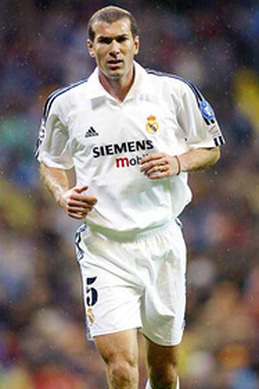
10. Zinedine Zidane
Att. Midfielder, France & Juventus/R.Madrid, 1990s/00s One of the greatest midfielders the game has ever known. Zidane played with such elegance, vision and sublime technique that when a film was made consisting solely of slow motion footage of him playing in one game it was taken entirely seriously as piece of art. In the 1998 World Cup Zidane succeeded where Platini had previously failed, winning the trophy to become a unifying symbol for his country. In truth he had not fully lived-up to his reputation until the Final when he rose to the occasion and scored twice to lift the trophy, although Brazil had problems of their own that day (see Ronaldo below). Zidane's greatest moment for France came two years later in Euro 2000 when he was the undisputed star of the competition and the inspirational player leading France to victory. After both he and his country disappointed in both the 2002 World Cup and Euro 2004 he surprised the world with an Indian summer in 2006, becoming the player of the tournament and unexpectedly taking France to the Final. Ill discipline has always been part of his game though; he missed several World Cup games due to suspension. This would cost him and his country in the 2006 Final, his last ever game, when he was sent off for headbutting Marco Materazzi, and France lost. By this point he had already been named player of the tournament. At club level he moved from France to join Juventus in 1996, where he proved himself a vital player for them from the outset. He helped them to win two league titles and reach two European Cup Finals but lost in both of them. In 2001 Zidane joined Real Madrid's Galaticos line-up in a 75 million Euro deal. There he would become arguably the team's most important player, scheming from midfield, passing with incredible vision, setting up assists and scoring exquisite goals. His greatest goal was probably the volley he scored in the 2002 Champions League Final, an individual piece of brilliance that finally won him the trophy. One of the very few players to be named European Footballer of the Year three times he remains a legend for both his international and club career.
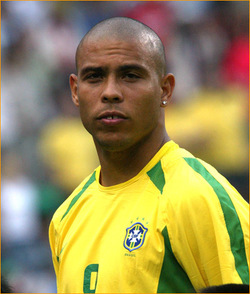
9. Ronaldo
Striker, Brazil & Barca/Inter/R. Madrid, 1990s/00s Ronaldo is a player with a great story, one that is interwoven with the history of the World Cup. When he led Brazil to the trophy in 2002, scoring 8 goals in the process, he was validating a personal comeback and claiming the recognition he deserved for his career up to that point. He exploded on the world scene with his one season at Barcelona in 1996/97, scoring 47 goals in 49 games and taking the club to a Cup Winners Cup trophy. His pace, dribbling and goalscoring ability was incredible, accompanied by a masterful close control gained from his early career as a futsal player. This was the best form of his career and he won the FIFA World Player in 1996 at the age of just 20. For Brazil, in the 1997 Copa America he formed a formidable partnership with Romario, driving his team to win the trophy, which he would win again in 1999. After just one season at Barcelona he moved to Inter Milan where he continued to impress, maintaining his impressive goal tally against tough Italian defences and expanding his repertoire with assists and free kicks, inspiring his club to win the UEFA Cup. He was the real star of the 1998 World Cup (winning the Golden Ball), in probably the best team in the tournament. We will probably never really know what happened on the day of the Final but the truth is that Ronaldo experienced some kind of seizure and, despite being eventually selected, was visibly far not himself in the game, which affected the whole team and led to France winning the trophy. Ronaldo succumbed to major injury at Inter, rupturing as knee tendon twice and missing most of two seasons, but recovering in time for the 2002 World Cup. It was amazing that he recovered to play at all, but he inspired another great Brazil team to win the 2002 World Cup, this time teaming up with Rivaldo and Ronaldinho. This led to the third of his FIFA World Player of the Year awards and sealed a major transfer to Real Madrid’s ’Galacticos’. He impressed for two years for Madrid and maintained an impressive goal ratio over his time there (83 goals in 127 games over 5 years). Most notably he starred in a 3-1 away demolition of Manchester United in which he scored a hatrick and was given a standing ovation by both sets of supporters (including this writer). At this point in his career he lacked the pace of his youth but this was compensated for by an innate understanding of where to be, and when, in order to score. By 2005 his party lifestyle and injury history were catching up with him. He played for AC Milan and for a succession of clubs in Brazil and retired in 2011. Part of two great teams: Real Madrid 1998-2005 and Brazil 1998-2002 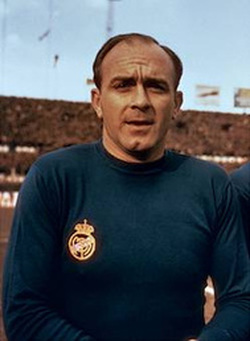
8. Alfredo di Stefano
Attacking Midfielder, Argentina/Spain & Real Madrid, 1950s The great Alfredo di Stefano was the undisputed leader, star player and eternal symbol of the greatest club side ever seen, leading Real Madrid to win five back-to-back European Cups, a feat that has not ever looked like being repeated since. In so doing he became an inspiration to countless other players, including several other legends on this list (notably Charlton and Eusebio). He also promoted the game, and more specifically the European Cup, earning praise throughout the world and bringing thousands flocking to see him. Di Stefano first came to prominence at River Plate in his native Argentina, developing his game with a loan spell at Huracan and a sojourn to Colombia's all-star break-away league. In 1953 he moved to Spain, with Real Madrid winning a tug-of-war for his services. At Madrid he was nominally a centre-forward but he would show great stamina shuttling back and forward to help and organise his defence and midfield [this makes him very difficult to categorise but we have listed him as an attacking midfielder]. Surely the most complete player the game has seen and in many ways the first modern footballer, he would drop back and receive the ball from the keeper. He could tackle, surge forward and not be missed in attack with his pace, still managing to score 216 goals in 282 games for Real. He scored in all five European Cup Finals between 1955 and 1960 and won the European Footballer of the Year award twice in this period. Di Stefano does not have the same track record at international level, playing for Spain after he left Argentina and never playing in a World Cup. His international career is not without success though - he helped Argentina win the 1947 South American Championship, scoring 6 goals in 6 games. Part of a great team: Real Madrid 1955-1960 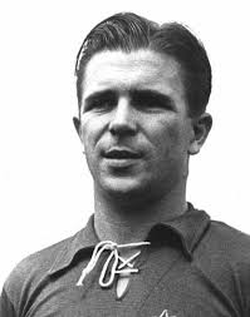
7. Ferenc Puskas
Inside Forward, Hungary & Honved/Real Madrid, 1950s Puskas was one of the greatest players of all time and an innovator of the way the game is played. He scored an incredible 83 goals in 85 games for Hungary and 514 goals in 529 games at club level. This makes him the most prolific international goalscorer of all time, incredibly a record that still stands today. Puskas effectively had two careers, each of which would place him on the list of legends. First he was the captain and star player in the great 'Magical Magyars' Hungary team of the 1950s - the team that beat England 6-3 at Wembley (and 7-1 in Budapest) and revolutionised tactical play, by introducing withdrawn forwards, fluid positional play and a strong team ethic, changing how football is played to this day. These tactics came jointly from the players and Puskas played a key role in implementing them on the pitch, even adapting play during games to exploit the opposition. Hungary were undoubtedly the best team in the world between 1950 and 1954; they were unbeaten in this period and had many stunning victories against other great sides, home and away. They were the favourites for the 1954 World Cup and looked set to win it with 9-0 and 8-3 victories in their early games (the second result was against West Germany). In the second game though Puskas fractured his angle, which kept him out of the next two games. Amazingly he played the Final, and scored, but could not lead Hungary to victory, indeed there were several questionable refereeing decision in this match. Hungary had another unbeaten run lasting until 1956 but in that year the Soviet tanks rolled in and Puskas became one of thousands of refugees to flee the country. Banned for 18 months by FIFA, lying low in Italy, two stone overweight it looked the end of his career. Instead he joined the famous Real Madrid side of Di Stefano (probably the greatest club side ever). There his success continued, he helped Madrid win two European Cups, scoring 4 goals in the 1960 Final, generally regarded as the best game of all time. He would score a hat-trick in the 1962 Final (which was not enough to beat Benfica) and would also play in the 1964 Final at the age of 37. Part of two great teams: Hungary 1950s and Real Madrid 19555-60 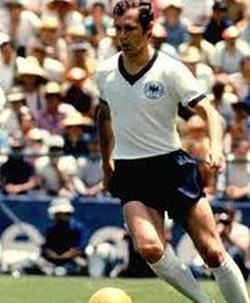
6. Franz Beckenbauer
Sweeper, W. Germany & Bayern Munich, 1960s/70s No one has ever achieved more success for both club and country then 'Der Kaiser'. For Bayern Munich he won three back-to-back European Cups from 1974-76. For his country he won the Wolrd Cup. After impressing in the 1966 and 1970 World Cups, and winning the 1972 European Championships, he captained his side to win the trophy in 1974. He would go on to win the World Cup again as manager in 1990. He made the All Star Team for all three World Cups he played in and was named the Best Young Player in 1966, where he marked Charlton out of the final. What is more impressive is that Beckenbauer was the most influential player in these great teams (both Bayern Munich and West Germany), and did this from a central defensive position rather than as a midfielder or forward, which is almost unparalleled. He genius also rests on the fact that he was tactically innovative, developing the role of the 'attacking libero' - starting from a sweeper position he surged forward to launch attacks. In addition to great positional awareness and tackling ability he had great vision and passing range. Moreover, he was a great leader, acting as captain and example for his team. Repeatedly recognised by his peers, he was twice winner of the European Footballer of the Year. In short, he achieved all he possibly could from his position, even expanding the parameters of how that position could be played, leading both his club and country teams to win the greatest trophies possible. Part of two great teams: Bayern Munich and West Germany 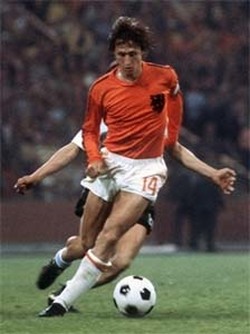
5. Johann Cruyff
Inside Forward, Netherlands & Ajax/Barcelona, 1970s Johann Cruyff was an incredibly skilful and creative player. He was also a great thinker about the game and leader on the pitch. He worked with his coach Rinus Michels to develop the Total Football system, in which players interchanged positions, attacked with fluidity and defended by closing down space. Cruyff pulled the strings on the pitch to implement this great vision and acted as inspiration to his team. A great dribbler, passer and goalscorer - so skilful that he developed his own move - the 'Cruyff turn' - he played with a verve and freedom that was a joy to watch. Nominally a striker, he would also drop deep to organise team and act as playmaker. With this new system, and his own genius, Cruyff, would help take Ajax from being a small local club to European heavyweights, winning three consecutive European Cups from 1970-72. In so doing he was named European Footballer of the Year three times. More signififcantly, Total Football would transform the way the game is played to this day. Michels and Cruyff took their tactical approach, and most of the Ajax players, to the Netherlands national team. Previously football minnows they now wowed the world in the 1974 World Cup. Looking like favourites from the start they came unstuck in Final against West Germany, seemingly beaten by their own focus on style above results, in contrast to the more ruthless Germans. Cruyff was the central figure in a very talented team and won the Golden Ball as player of the tournament. A bad experience with the media unfortunately meant that he ruled himself out of the 1978 World Cup. His teammates would go to the Final again and lose to the hosts Argentina. With Cruyff in the team they may well have won. As it was, they remain one of the greatest teams never to have won the World Cup. Cruyff left Ajax for Barcelona, where we again be instrumental in changing the tactics and becoming the star of the team. When he returned as manager he put in place a way of playing that has informed the tactical approach of the club ever since, and leading his 'dream team' to a European Cup win in 1992. His influence as a player, and manager, has fundamentally shaped the way the game is played today. He sadly passed away in 2016, Ajax have since announced their stadium will be renamed in his honour. Part of two great teams: Ajax 1970-73 and Netherlands 1974-78 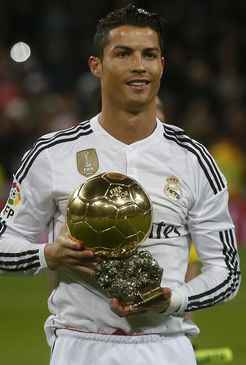
4. Cristiano Ronaldo
Winger/Striker, Portugal & Man Utd/Real Madrid, 2000s/10s A modern day great that sits comfortably alongside past legends. Ronaldo was signed at 18 by Manchester United after impressing in a pre-season friendly and he would go on to inspire the club to three league titles and a European Cup win in 2008. Always an exciting dribbler gifted with pace, United transformed him from an out-and-out winger to a more complete player that drifted infield and scored a phenomenal number and range of goals. He is also a great free-kick and penalty taker. After moving to Real Madrid he would continue his astonishing goal record, despite mostly starting from wide positions, and he continues to perform with remarkable consistency. Becoming the key player in a great side he lit up La Liga with a personal rivalry with Lionel Messi, leading his club to a tenth European Cup win in 2014. It is his misfortunate to share the stage with the slightly superior Messi but that has not stopped him winning the Ballon d'Or/European Footballer of the Year an incredible four times (once with Manchester United). He may be more comfortable in the limelight, and perhaps he is driven by egotism, but he has always matched his talent with great dedication and won the respect and admiration of his teammates. Now surely Portugal’s greatest ever player, Ronaldo has played in three World Cups but unfortunately disappointed in all of them, otherwise he would have been higher in this list. However he inspired Portugal to win the 2016 European Cup, showing great leadership and influence in the Final from the touchline when he was injured early in the game. Part of a great team: Man Utd 1999-2009 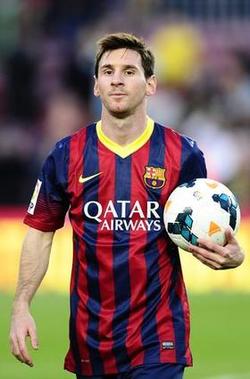
3. Lionel Messi
Right Winger/Support Striker, Argentina & Barcelona, 2000s/10s The best player playing today and the star of a remarkable Barcelona team for over ten years. Messi is a creative forward that can play from wide or central positions, drifting from deep, beating players and setting up and scoring goals seemingly out of nowhere, and being the creative pulse of the team. He has shown remarkable consistency in La Liga, scoring 278 goals in 309 games, and scoring more goals than the number of games played in three seasons, including an astonishing record 73 goals in all competitions 2011/12. He has won the Ballon D'Or five times, more than anyone else ever, and is the all-time leading scorer in the European Cup. His form for Argentina, while still impressive has generally not matched his club form and he is not revered in his home country the same way that Maradona still is. That is until he won the Copa America in 2021, and then, in the twilight of his career, he led his country to winning the World Cup in 2022, deservedly collecting the Golden Ball as the tournament's best player. This instantly ended the Messi vs Ronaldo debate and placed Messi alongside his compatriot Maradona. Part of a great team: Barcelona 2006-2012 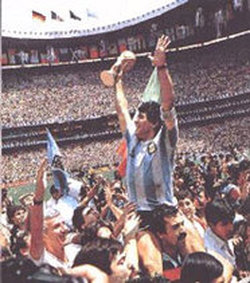
2.Diego Maradona
Att. Midfielder, Argentina & Barcelona/Napoli, 1980s/90s There may be several legends on this list that have led their teams to win the World Cup but no other can claim to have done this single-handedly to the extent that Diego Maradona did in 1986, scoring five goals and making five assists in seven games. The Argentina team of that year included a few very good players (Valdano, Burruchago) but they were by no means a great team and would certainly not have won the trophy without Maradona. Playing in a free attacking midfield role he would pick up the ball from deep, beat players and set up chances with great vision, or often he would go on long dribbling runs and score spectacular individual goals by himself. Nowhere was this more apparent that his second goal in the quarter-final against England where he dribbled from his own half and scored. This is generally regarded as the greatest World Cup goal ever scored and perfectly captures his genius: creating chances from nothing and using mesmerising control to score spectacular goals. His influence on his team was therefore immense, and by extension he has become a hero for his country, transcending football. Through the appeal of watching him play he also became a standard bearer for football itself, being named the Player of the Tournament for that World Cup (probably the easiest choice for this award ever) and was one of the key players to watch in the 1990 and 1994 tournaments (after failing to live up to expectations in 1982). Evidence of his importance can be seen in the number of opposition players that marked him in these later campaigns. Although never reaching the same heights as 1986 he was always capable of producing moments of brilliance and he won third place for the Golden Ball in 1990. To underscore his individual importance Maradona delivered similar success at club level. His club career may have been patchy, after bursting onto the scene at Boca Juniors he generally disappointed after a major transfer to Barcelona (for various reasons), but it was at Napoli that he enhanced his reputation. Joining this underachieving, unfashionable club, he led them to challenge the northern elite and win two league titles and a UEFA Cup. His ‘street-fighting’ style - of fighting for the underdog and using dirty tricks when he needed to (such as his first goal hand-ball against England in 1986), seemed to suit his blue-collar choice of clubs (Boca Juniors and Napoli), and doubtless derived from his background in a poor barrio of Buenos Aires. It is this also that fits elements of the Argentine character and elevates him to a national hero. There is of course another side of Maradona. His willingness to cheat extended beyond the pitch and he dramatically failed a doping test that ruled him out of the remainder on the 1994 World Cup. This followed a similar ban for cocaine use three years earlier. His poor professional discipline has certainly limited the longevity of his achievements but what he achieved when he was at his best is enough to place him very highly in the pantheon of legends, though perhaps eternally second to... 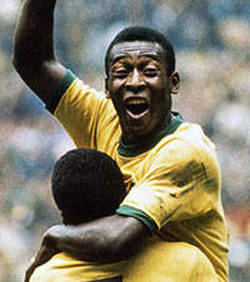
1. Pele Inside Forward, Brazil & Santos, 1950s-70s Pele is and always will be the greatest footballer ever. It is a role he wears very comfortably. His play, full of joy and exuberance, seems to sum up everything that the world loves about the game and as he travels the globe acting as its greatest ambassador his own legend is reinforced. He is fully deserving of this title though. He remains the only player ever to inspire his country to win the World Cup twice: in 1958 and 1970 (injury ended his 1962 campaign early). His team-mate Garrincha runs him close but Pele was the clear star of two teams, just eclipsing Garrincha in 1958. He was only 17 when he was introduced in the 1958 tournament in Sweden, he then scored a hat-trick to help his team reach the final and scored twice in the final itself. His tears at the final whistle showed a humanity that endeared the watching world to him from then on. The following year he was named best player in the 1959 South American Championship, scoring 8 goals. His participation was limited by injury in the 1962 World Cup and Brazil were beaten by heavy tackling in 1966. By 1970 he was coaxed out of his intended retirement to lead another, wholly different all-star team to glory. He played as a classic number 10, dropping back and engaging in some impeccable link-up play and demonstrating great vision - his pass to a seemingly unseen Carlos Alberto for the fourth goal in the 1970 Final remains the best lay-off in history. He could also beat players and score gaols in a great variety of ways, showing that he really was the complete forward. He remains Brazil's record goalscorer. He is also separated from other legends by the fact that he has proven himself equally through his club career. He remained in Brazil, at Santos throughout his prime years and was the star attraction in a team that swept all before them. It is true that they played a lot of unimportant friendly matches, but they also played some very important games. After winning the Copa Libertadores in both 1962 and 1963, each time they unequivocally answered any questions of relative worth in comparison with European football by comprehensively beating that years European Cup winners: beating Benfica 5-2 away in 1962 and seeing off AC Milan in 1963, both opponents among the greatest club sides of all time. 650 goals in 694 competitive club games tells its own story (nevermind the 1000+ goals that also included friendlies). Pele is now a true global icon, one of very few in sport, and is indivisbly linked to the game in the public imagination. When the world thinks of football it thinks of Pele, and not just football but el joga bonito (the 'beautiful game') as Pele named it. It is an association that football benefits from, and that is the best summary of why Pele is number 1. Part of three great teams: Santos 1962-63, Brazil 1958-62 and Brazil 1970
The Next Best 12
An Honourable Mention to 12 players that narrowly missed out (in alphabetical order): Roberto Baggio (SS) Italy 1990s Cafu (RB) Brazil 1990s/00s Ruud Gullit (SS) Netherlands 1980s/90s Paolo Maldini (LB) Italy 1980s/90s/00s Lothar Matthaus (B2B) Germany 1980s/1990s Sir Stanley Matthews (RW) England 1930s/40s/50s Giuseppi Meazza (IF) Italy 1930s Bobby Moore (CB) England 1960s/70s Gerd Muller (STR) Germany 1970s Romario (STR) Brazil 1990s/2000s Matthias Sindelar (IF) Austria 1920s/30s Juan Schiaffino (IF) Uruguay 1950s
Comments
Do you agree with our top 20? In the order we have picked? Who do you think is the greatest and why? Use the forum below to leave your comments. |
|
| Football's Greatest |
|
- Home
- About
- Legends
- Best Players by Position
-
National Teams
- Uruguay 1924-30
- Austria 1930s
- Italy 1934-38
- England 1948
- Hungary 1950s
- Germany 1954
- Brazil 1958-62
- England 1966
- Brazil 1970
- Germany 1966-74
- Netherlands 1974-78
- Argentina 1978
- Italy 1982
- Brazil 1982
- France 1982-86
- Netherlands 1988
- Germany 1990-96
- Brazil 1998-2002
- France 1998-2006
- Spain 2008-14
- Germany 2006-
-
Club Teams
- River Plate 1941-47
- Real Madrid 1955-1960
- Benfica 1960s
- Santos 1962-63
- Inter Milan 1960s
- Celtic 1967
- Man Utd 1963-68
- AC Milan 1963-69
- Ajax 1970-73
- Bayern Munich 1974-76
- Liverpool 1977-85
- Juventus 1982-85
- AC Milan 1988-1994
- Barcelona 1989-94
- Ajax 1995-1996
- Juventus 1996-1998
- Real Madrid 1998-2005
- Man Utd 1999-2009
- AC Milan 2003-2007
- Barcelona 2006-11
- Real Madrid 2016-18
- Dream Teams
- Women Players
- Recommended Products

